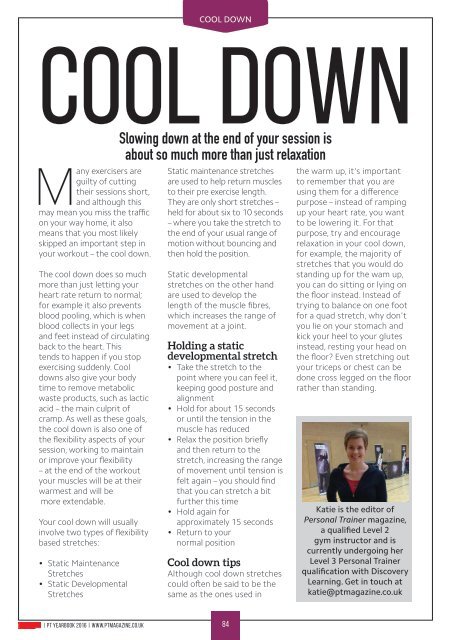You also want an ePaper? Increase the reach of your titles
YUMPU automatically turns print PDFs into web optimized ePapers that Google loves.
cool down<br />
Cool down<br />
Slowing down at the end of your session is<br />
about so much more than just relaxation<br />
Many exercisers are<br />
guilty of cutting<br />
their sessions short,<br />
and although this<br />
may mean you miss the traffic<br />
on your way home, it also<br />
means that you most likely<br />
skipped an important step in<br />
your workout – the cool down.<br />
The cool down does so much<br />
more than just letting your<br />
heart rate return to normal;<br />
for example it also prevents<br />
blood pooling, which is when<br />
blood collects in your legs<br />
and feet instead of circulating<br />
back to the heart. This<br />
tends to happen if you stop<br />
exercising suddenly. Cool<br />
downs also give your body<br />
time to remove metabolic<br />
waste products, such as lactic<br />
acid – the main culprit of<br />
cramp. As well as these goals,<br />
the cool down is also one of<br />
the flexibility aspects of your<br />
session, working to maintain<br />
or improve your flexibility<br />
– at the end of the workout<br />
your muscles will be at their<br />
warmest and will be<br />
more extendable.<br />
Your cool down will usually<br />
involve two types of flexibility<br />
based stretches:<br />
• Static Maintenance<br />
Stretches<br />
• Static Developmental<br />
Stretches<br />
Static maintenance stretches<br />
are used to help return muscles<br />
to their pre exercise length.<br />
They are only short stretches –<br />
held for about six to 10 seconds<br />
– where you take the stretch to<br />
the end of your usual range of<br />
motion without bouncing and<br />
then hold the position.<br />
Static developmental<br />
stretches on the other hand<br />
are used to develop the<br />
length of the muscle fibres,<br />
which increases the range of<br />
movement at a joint.<br />
Holding a static<br />
developmental stretch<br />
• Take the stretch to the<br />
point where you can feel it,<br />
keeping good posture and<br />
alignment<br />
• Hold for about 15 seconds<br />
or until the tension in the<br />
muscle has reduced<br />
• Relax the position briefly<br />
and then return to the<br />
stretch, increasing the range<br />
of movement until tension is<br />
felt again – you should find<br />
that you can stretch a bit<br />
further this time<br />
• Hold again for<br />
approximately 15 seconds<br />
• Return to your<br />
normal position<br />
Cool down tips<br />
Although cool down stretches<br />
could often be said to be the<br />
same as the ones used in<br />
the warm up, it's important<br />
to remember that you are<br />
using them for a difference<br />
purpose – instead of ramping<br />
up your heart rate, you want<br />
to be lowering it. For that<br />
purpose, try and encourage<br />
relaxation in your cool down,<br />
for example, the majority of<br />
stretches that you would do<br />
standing up for the wam up,<br />
you can do sitting or lying on<br />
the floor instead. Instead of<br />
trying to balance on one foot<br />
for a quad stretch, why don't<br />
you lie on your stomach and<br />
kick your heel to your glutes<br />
instead, resting your head on<br />
the floor? Even stretching out<br />
your triceps or chest can be<br />
done cross legged on the floor<br />
rather than standing.<br />
Katie is the editor of<br />
Personal Trainer magazine,<br />
a qualified Level 2<br />
gym instructor and is<br />
currently undergoing her<br />
Level 3 Personal Trainer<br />
qualification with Discovery<br />
Learning. Get in touch at<br />
katie@ptmagazine.co.uk<br />
| PT YEARBOOK 2016 | WWW.PTMAGAZINE.CO.UK<br />
84


